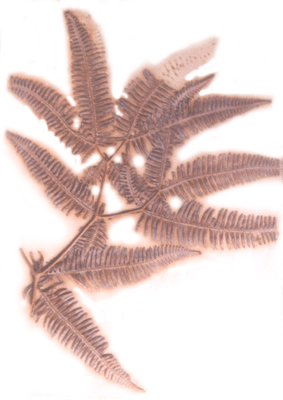 |
Introduction to Pteridophytes
Pteridophytes are the
first land plants and are called 'Vascular Cryptogams' ,because they have the vascular tissue
namely the xylem and phloem. They are the highly advanced group among cryptogams and they
include both living and fossil plants. The carboniferous period was called the 'Age of the
Ferns'.
The plants are
generally Sporophyte and is differentiated into root, stem, and leaves-that is called
"Cormophyte". Branching may be dichotomous (or) monopodial, the leaves are of two
types, one is microphyllus (ex: Lycopodium) and another is megaphyllus (fern leaf) and when
the leaves are young they exhibit circinate venation. The function of the leaf is
photosynthesis but in fern like Nephrolopis the leaves are both photosynthetic and
reproductive; in the mature stage they bear the structure called 'Sori'. The plant is attached
to the substratum by means of roots.
Presence of stele in the root and
stem of pteridophytes have the vascular tissue, the xylem, phloem and pith are called
'stele'. The stele types varies from Protostele to a Dictyostele. Secondary thickening was
commonly seen among fossil plants. In the present day pteridophytic plants only two
plants alone show a kind of secondary thickening - Isoetes and Botrychium.
Pteridophytes are classified
into two types by the spores; some are Homosporous (ex: lycopodium;). They produce only
one type of spores, the other one is heterosporous (ex: selaginella). They produce two
different kinds of spores, the smaller one is micro spore and the larger one is megaspore.
The ferns exhibit alternation of
generation with separate multi-cellular spore-forming (sporophyte) and gamete forming
(gametophytes) stages in their life cycle. Various living and fossil ferns are exhibited in
the Systematic Botany Gallery. |

|
Equisetum
Horse-tail
The word 'Equisetum', comes from the Latin word equus
"horse" and saeta, "bristle". It is a pteridophytic plant belonging to the
division 'Phenophyta'. It is commonly called "Horsetails". The genus equisetum has
about 15 species. It grows mostly in wet, marshy habitats and are small. They are widely
distributed throughout the world. It has true roots, stems and leaves. Their hollow jointed
stems are impregnated with silica, which gives them a gritty feelings; it is attached to the
substratum by means of rhizomes that also bear wiry roots. The scale-like leaves, which are
small megaphyllus are fused in whorls at each node and are quite small. The green stem is the
main organ of photosynthesis. |
Alsophila
It is a genus of tree fern, belonging to the family
'Cyathiaceae'. It is a perennial plant, which live in moist shady places, particularly in
mountainous region. It has an erect stem that may grow to heights of 23 metres and have
leaves 5 metres (or) more in length. The leaves are well-developed, often of very large size
which are rolled in- wards as buds, strengthening out as they mature. The plant is exhibited
in the Systematic Botany Gallery.
|

|
| 
|
Osmunda
It is a 'Pteridophyte', plant and is a fern. The Genus
'Osmunda' consists of 14 species which are cosmopolitan in distribution. It is commonly called
the lower fern. The plant is a 'sporophyte' and grows in moist shady places. It has got an
underground stout rhizome, which has completely covered a mantle of roots. The rhizome at the
top bears a crown of pinnately compound leaves. The leaves when young exhibit circinate
vernation. The vernation of leaflets is open dichotomous.
The plant is displayed as herbarium in the Systematic Botany Gallery. |
Gleichenia
It is a pteridophyte plant belonging to the family
'Gleicheniaceae'. It usually occurs in exposed localities and form dense and bushy growths. In
India, it is found in Western Ghats, Eastern Himalayas and Kumanon hills. The plant
is sporophyte and is distinguished into long, dichotomously branched, prostrate and
subterranean rhizome; it bears leaves on the upper surface and adventitious roots on the lower
(or) under surface. The leaves of this genus are characteristic which arise at longer
intervals to be borne in three rows. They range in length from a few feet to more than 50
metres.
The plant is kept as herbarium in the Systematic Botany Gallery.
|

|
|

|
|